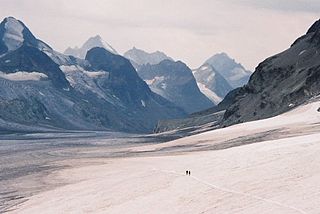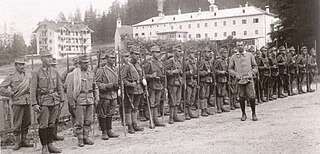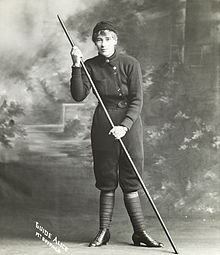
Mountaineering, mountain climbing, or alpinism is a set of outdoor activities that involves ascending mountains. Mountaineering-related activities include traditional outdoor climbing, skiing, and traversing via ferratas that have become sports in their own right. Indoor climbing, sport climbing, and bouldering are also considered variants of mountaineering by some, but are part of a wide group of mountain sports.

A guide is a person who leads travelers, sportspeople, or tourists through unknown or unfamiliar locations. The term can also be applied to a person who leads others to more abstract goals such as knowledge or wisdom.

Ski mountaineering is a skiing discipline that involves climbing mountains either on skis or carrying them, depending on the steepness of the ascent, and then descending on skis. There are two major categories of equipment used, free-heel Telemark skis and skis based on Alpine skis, where the heel is free for ascents, but is fixed during descent. The discipline may be practiced recreationally or as a competitive sport.

The Haute Route is the name given to a route undertaken on foot or by ski touring between the Mont Blanc in Chamonix, France, and the Matterhorn, in Zermatt, Switzerland.

Ski touring is skiing in the backcountry on unmarked or unpatrolled areas. Touring is typically done off-piste and outside of ski resorts, and may extend over a period of more than one day. It is similar to backcountry skiing but excludes the use of a ski lift or transport.

Gaston Rébuffat was a French alpinist, mountain guide, and author. He is well known as a member of the first expedition to summit Annapurna 1 in 1950 and the first man to climb all six of the great north faces of the Alps. In 1984, he was made an officer in the French Legion of Honour for his service as a mountaineering instructor for the French military. At the age of 64, Gaston Rébuffat died of cancer in Paris, France. The climbing technique Gaston was named after him. A photo of Rébuffat atop the Aiguille du Roc in the French Alps is on the Voyager Golden Records.

Gebirgsjäger are the light infantry part of the alpine or mountain troops (Gebirgstruppe) of Germany, Austria and Switzerland. The word Jäger is a characteristic term used for light infantry in German speaking countries.

Verbier is a village located in south-western Switzerland in the canton of Valais. It is a holiday resort and ski area in the Swiss Alps and is recognised as one of the premier off-piste resorts in the world. Some areas are covered with snow all year. Skiers have settled in the Verbier area in order to take advantage of the steep slopes, varied conditions, and resort culture.
Steve House is an American professional alpinist and mountain guide, and winner of the 2006 Piolet d'Or.
The American Mountain Guides Association (AMGA) is the United States' "sole representative to the 21-member International Federation of Mountain Guides Associations (IFMGA), the international governing body responsible for guiding standards and education around the world". AMGA is a non-profit organization that seeks to represent the interests of American mountain guides by providing support, education, and standards. The Association offers training courses and certification exams in rock, alpine and ski mountaineering.

The Mountain Warfare Training Center (MWTC) is a United States Marine Corps installation located in Pickel Meadows on California State Route 108 at 6,800 feet (2,100 m) above sea level in the Toiyabe National Forest, 21 miles (34 km) northwest of Bridgeport, California. The training center exists to train units in complex compartmented terrain.

The Union of International Mountain Leader Associations (UIMLA) was founded in November 2004. It was decided at the meeting that all mountain leader associations would be awarded the same carnet and badge giving an internationally recognised identity. It also paves the way for other countries from around the world to join UIMLA setting a world standard for mountain leaders. The principal aims of UIMLA are:
Victor Saunders is a British mountaineer and author. He trained as an architect at the Architectural Association School of Architecture in London. His first book, Elusive Summits, won the Boardman Tasker Prize for Mountain Literature in 1991. He became as a UIAGM/IFMGA ski and mountain guide in 1996 and joined the SNGM in 2003. Saunders first reached the summit of Mount Everest in May 2004, and went on to climb it several more times. In 2020 he became president of the Alpine Club.
A mountain leader is a military professional specialising in delivering training for, or leading, operations in high altitude and / or extremely low temperature environments.

Yamnuska Mountain Adventures is a mountaineering school and mountain adventure company located in Canmore, Alberta, Canada. The company was founded in 1975.

Roger Payne was a British mountaineer. He was formerly general secretary of the British Mountaineering Council (BMC) and a qualified mountain guide from 1983, taking part in over 20 expeditions to the Karakoram and Himalayan ranges, including K2 and the north face of Changabang. He was an avalanche instructor and climbed in the Alps every year from 1977.

The Alpine companies were specialized mountain infantry troops that were part of the Austro-Hungarian land forces during the First World War.

The British Army Mountaineering Association (AMA) is the governing body for climbing competitions and the representative body for mountaineering in the British Army. It is a member of the British Mountaineering Council and is the largest climbing club in the United Kingdom.

Mountain Madness is a Seattle-based mountaineering and trekking company. The company specializes in mountain adventure travel and has a training school for mountain and rock climbing.
The École militaire de haute montagne (ÉMHM) is a training establishment of the French Army, that trains French and allied service personnel in mountain warfare, skiing, mountain leadership, and arctic warfare.


















